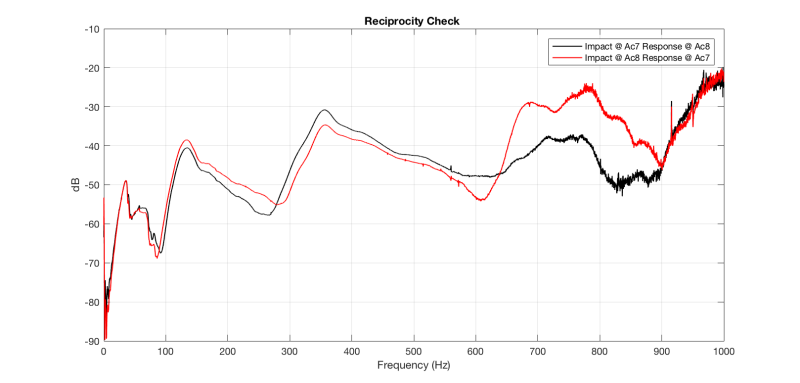I have done an impact test on a railway sleeper which was embedded into railway ballast.
I did impacts at 11 points along the sleeper, and I have gathered acceleration for each of the impacts at 11 points of the sleeper, i.e. I had 11 impact/reference points and 11 response points (accelerometers).
For each impact point I have obtained eleven FRFs. So for one sleeper tested I am dealing with 121 FRF curves.
I need some advice how to proceed in getting the modal parameters. To be honest, I am pretty stuck at this steps for weeks
At the moment I am dealing with RFP technique for modal parameters extraction. I've found a very useful Matlab code online on Mathworks website.
The thing is I got some strange numbers while doing the fitting, e.g. negative damping ratios even though the fit looks almost perfect. This is one of the major problems now.
I admit, my data is not perfect all, but I should get something from it, because I see highly damped peaks. Also plotting the imaginary FRF along the sleeper, there are first four modes visible (up to 670 Hz). Individual FRFs are somehow similar, with almost same locations of peaks in the frequency range of interest.
I don't know am I on the right track. I know that RFP is an old technique, but for me the time is the biggest problem because I don't have it and the deadline is around the corner. Also, I don't have available any of the software that will do all the hard work for me.
So, I just want an advice of an experienced person, how to proceed. How can I take into account all 121 FRFs and at the end get the final experimental frequencies, mode shapes and damping ratio (if possible)?
Many thanks in advance,
Emina
Emina B.
I did impacts at 11 points along the sleeper, and I have gathered acceleration for each of the impacts at 11 points of the sleeper, i.e. I had 11 impact/reference points and 11 response points (accelerometers).
For each impact point I have obtained eleven FRFs. So for one sleeper tested I am dealing with 121 FRF curves.
I need some advice how to proceed in getting the modal parameters. To be honest, I am pretty stuck at this steps for weeks
At the moment I am dealing with RFP technique for modal parameters extraction. I've found a very useful Matlab code online on Mathworks website.
The thing is I got some strange numbers while doing the fitting, e.g. negative damping ratios even though the fit looks almost perfect. This is one of the major problems now.
I admit, my data is not perfect all, but I should get something from it, because I see highly damped peaks. Also plotting the imaginary FRF along the sleeper, there are first four modes visible (up to 670 Hz). Individual FRFs are somehow similar, with almost same locations of peaks in the frequency range of interest.
I don't know am I on the right track. I know that RFP is an old technique, but for me the time is the biggest problem because I don't have it and the deadline is around the corner. Also, I don't have available any of the software that will do all the hard work for me.
So, I just want an advice of an experienced person, how to proceed. How can I take into account all 121 FRFs and at the end get the final experimental frequencies, mode shapes and damping ratio (if possible)?
Many thanks in advance,
Emina
Emina B.


